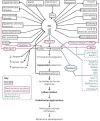The critical issue linking lipids and inflammation: Clinical utility of stopping oxidative stress
- PMID: 36439997
- PMCID: PMC9682196
- DOI: 10.3389/fcvm.2022.1042729
The critical issue linking lipids and inflammation: Clinical utility of stopping oxidative stress
Abstract
The formation of an atheroma begins when lipoproteins become trapped in the intima. Entrapped lipoproteins become oxidized and activate the innate immune system. This immunity represents the primary association between lipids and inflammation. When the trapping continues, the link between lipids and inflammation becomes chronic and detrimental, resulting in atherosclerosis. When entrapment ceases, the association between lipids and inflammation is temporary and healthy, and the atherogenic process halts. Therefore, the link between lipids and inflammation depends upon lipoprotein retention in the intima. The entrapment is due to electrostatic forces uniting apolipoprotein B to polysaccharide chains on intimal proteoglycans. The genetic transformation of contractile smooth muscle cells in the media into migratory secretory smooth muscle cells produces the intimal proteoglycans. The protein, platelet-derived growth factor produced by activated platelets, is the primary stimulus for this genetic change. Oxidative stress is the main stimulus to activate platelets. Therefore, minimizing oxidative stress would significantly reduce the retention of lipoproteins. Less entrapment decreases the association between lipids and inflammation. More importantly, it would halt atherogenesis. This review will analyze oxidative stress as the critical link between lipids, inflammation, and the pathogenesis of atherosclerosis. Through this perspective, we will discuss stopping oxidative stress to disrupt a harmful association between lipids and inflammation. Numerous therapeutic options will be discussed to mitigate oxidative stress. This paper will add a new meaning to the Morse code distress signal SOS-stopping oxidative stress.
Keywords: lipoprotein retention; oxidative stress; platelet-derived growth factor; proteoglycans; remnant cholesterol; smooth muscle cell transformation.
Copyright © 2022 Bale, Doneen, Leimgruber and Vigerust.
Conflict of interest statement
The authors declare that the research was conducted in the absence of any commercial or financial relationships that could be construed as a potential conflict of interest.
Figures

References
Publication types
LinkOut - more resources
Full Text Sources

